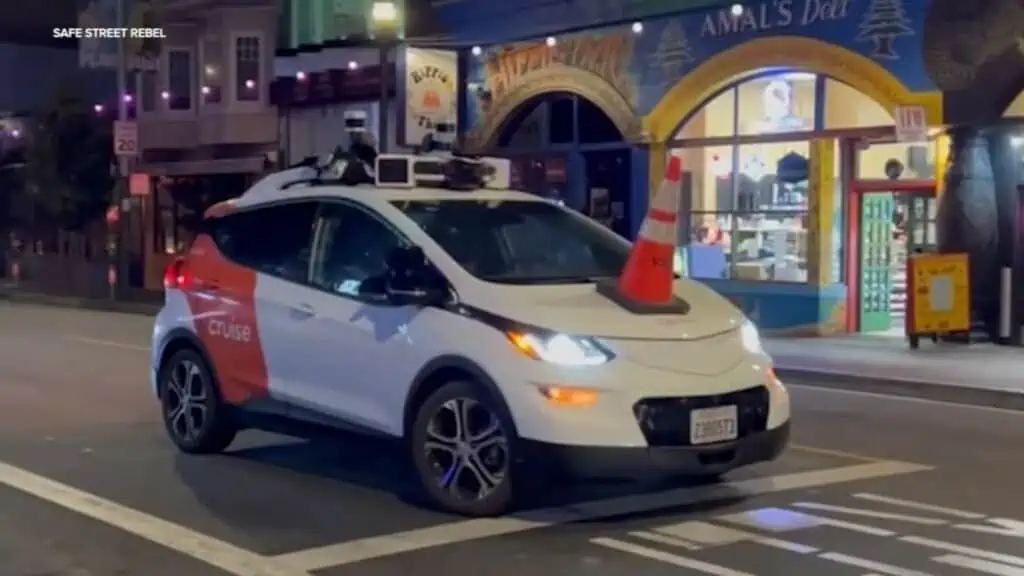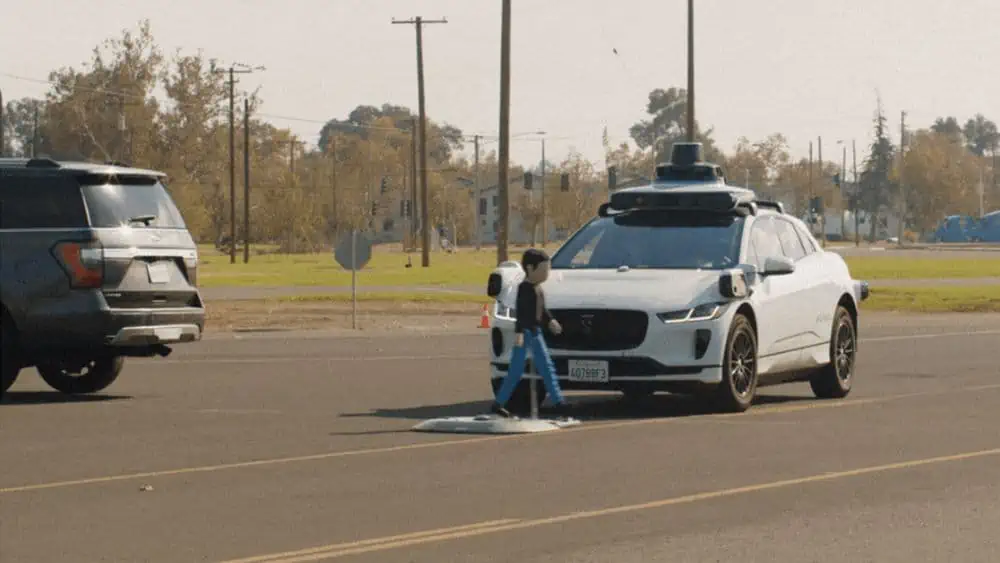
(Source: ABC7 News Bay Area)
By Colin Barnden
What’s at stake:
Cruise and Waymo want to significantly expand operations in San Francisco. But why are the concerns of city officials and residents not being listened to?
San Franciscans have had enough. A group of activists operating under the name “Safe Streets Rebel” are encouraging their fellow citizens to disable robotaxis by placing traffic cones onto vehicle hoods. The story has been well documented online and in the broadcast media:
The technique is highly effective and no more sophisticated than the modern-day equivalent of defending one’s territory with a sharp stick.
But why the rebellion? The answer is simple: No one is listening to the residents of San Francisco.
They didn’t consent to being used as human guinea pigs by billion-dollar tech companies testing experimental AVs on public roads. Neither did they agree to their daily commutes being disrupted by brittle robotaxis which block transit routes indiscriminately.
They watch Jeffrey Tumlin, the San Francisco Municipal Transportation Agency Director of Transportation call Cruise and Waymo robotaxis “unsafe” and listen as local public safety and transit officials call for a slowdown of Cruise’s and Waymo’s expansion plans.
But nothing changes. Now anger is rising, and the rebels are fighting back.
Super (expensive) AEB
Cruise and Waymo both rely on the same modus operandi, which is to repeat over and over that their robotaxis are safer than an “average human driver.” The latest safety blog from Mauricio Peña, Waymo’s Chief Safety Officer, dated July 6 leads: “The Waymo Driver is already improving road safety.” Reading on, the tone is no less triumphalist:
There’s no single metric or methodology that on its own can positively prove that an autonomous driving system is safe. But when looking at all the data available to us, including the rigorous analyses we’ve published over the years, it’s clear that the Waymo Driver is already reducing traffic injuries and fatalities in the cities where we operate.
Peña continues:
Developing technology that minimizes the probability and severity of traffic crashes has been Waymo’s goal from the start.
The blog post includes a video of the Waymo Driver successfully avoiding a series of collisions, including this screenshot:

Another name for a technology that minimizes the probability and severity of traffic crashes is automatic emergency braking, or AEB. Indeed, the scenarios demonstrated in the blog are no more demanding than Euro NCAP’s 2023 test protocols for AEB for vulnerable road users.
Peña continues to throw shade at human driving, observing:
Human behavior–including intoxication, speeding, drowsiness, and inattentiveness–plays a critical role in the vast majority of these needless tragedies.
Improved road safety is a federal, not a city, goal and would also be achieved if NHTSA (National Highway Traffic Safety Administration) were to follow the lead of the European Union and mandate technology such as AEB for vulnerable road users, and vision-based driver monitoring systems that would make human drivers safer and improve dramatically the performance of an “average human driver.”
Cruise and Waymo have spent about ten billion dollars each to develop the transportation industry’s most expensive AEB. For that much money, these companies really ought to have developed technology which greatly improves safety outcomes.
Reports suggest Waymo’s current fleet consists of about 200 cars in San Francisco. In a city with a population of about 800,000 people, Waymo’s contribution to safety outcomes will be marginal, but robotaxis are so brittle that San Francisco’s public transit users are inconvenienced almost daily.
Robotaxis continue to interfere with first responders and will continue to do so until the technology is sufficiently robust to interact with humans and other human driven vehicles in the ambiguous, uncertain, and unpredictable scenarios common on public roads.
Consequences and accountability
If robotaxis really are safe, then why have some San Franciscans begun to take the law (and traffic cones) into their own hands? The answer has nothing to do with safety, but instead an absence of regulatory oversight. There is neither consequence nor accountability when Cruise and Waymo block public transit and first responders.
One possible way forward has been proposed by Phil Koopman, an associate professor at Carnegie Mellon University who, writing in a LinkedIn post, suggested:
Put an in-vehicle valet (a licensed driver riding “shotgun”) in each uncrewed vehicle UNTIL they [Cruise and Waymo] can demonstrate with real-world data that they are no longer interfering with emergency services — and only then take the backup driver out. This is the least the companies can do in exchange for the privilege of using public roads as testbeds for their still-maturing technology.
It is such a simple and effective solution that it is unlikely to be adopted. Instead, Cruise and Waymo will continue the sermons about safety and saving lives, continue to block public transit in San Francisco, and ever more robotaxis will be disabled by traffic cones.
For all of our failings, humans have three things that machine drivers don’t: Ingenuity, hands, and a great sense of humor.
Bottom line:
Cruise and Waymo need to be reminded that public roads are a shared resource, and not everyone wants to share the roads with them.
Colin Barnden is principal analyst at Semicast Research. He can be reached at [email protected].
Copyright permission/reprint service of a full TechSplicit story is available for promotional use on your website, marketing materials and social media promotions. Please send us an email at [email protected] for details.
